Cite this document
(“Supreme Court Trilogy Decisions in 1960 Case Study”, n.d.)
Supreme Court Trilogy Decisions in 1960 Case Study. Retrieved from https://studentshare.org/miscellaneous/1520881-supreme-court-trilogy-decisions-in-1960
Supreme Court Trilogy Decisions in 1960 Case Study. Retrieved from https://studentshare.org/miscellaneous/1520881-supreme-court-trilogy-decisions-in-1960
(Supreme Court Trilogy Decisions in 1960 Case Study)
Supreme Court Trilogy Decisions in 1960 Case Study. https://studentshare.org/miscellaneous/1520881-supreme-court-trilogy-decisions-in-1960.
Supreme Court Trilogy Decisions in 1960 Case Study. https://studentshare.org/miscellaneous/1520881-supreme-court-trilogy-decisions-in-1960.
“Supreme Court Trilogy Decisions in 1960 Case Study”, n.d. https://studentshare.org/miscellaneous/1520881-supreme-court-trilogy-decisions-in-1960.


